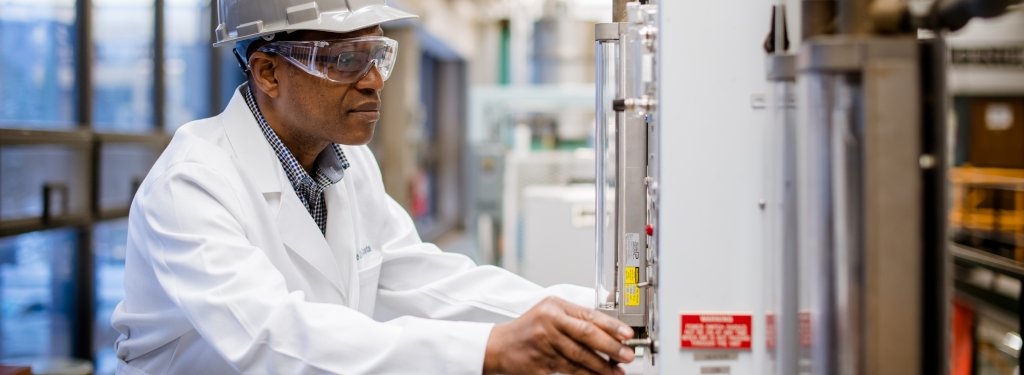French onion soup, the Cuban sandwich, process safety. Just a few recipes that wouldn't be the same without the crater-infused cheese: Swiss.
Beyond being a staple for comfort foods, Swiss cheese plays an important role in adopting a safety-oriented cultural mindset, which is essential for students working in Michigan Tech labs, and workers on oil tankers and at milling plants. The campus steward of the Swiss cheese for safety mindset—known formally as process safety—is Professor of Chemical Engineering and Herbert H. Dow Chair in Chemical Process Safety, Andre Da Costa.
Applying Swiss Cheese to COVID-19
Not a weird home remedy. As we look at ways to prevent the spread of COVID-19, many have turned to the Swiss cheese model. It helps explain how masking, quarantine, vaccines and handwashing work together.
Put simply, his interest is in preventing the injuries, fatalities and damage that can potentially result from human error in hazardous environments, including but not limited to research labs. Da Costa brings more than 20 years of experience developing, promoting, disseminating and supporting implementation of process safety in industry and academia to Michigan Tech. But it is his compassion for humanity and the environment that drives him and his mission to thread process safety into our campus DNA.

Everything's Better with Cheese
Enter the Swiss cheese model of process safety, which illustrates, through layers in a block of Swiss cheese, the processes that can both prevent and cause safety concerns. According to Da Costa, we should think of a potential safety hazard as a beam of light. Swiss cheese is punctured with holes—the vulnerabilities in a system that can lead to an incident. The light—the hazard—could potentially shine through the gap in the cheese, the system's hole can result in an incident-like an explosion, a chemical spill and resulting skin burn or worse. Da Costa wants us to move beyond the single slice of Swiss, or the system without a process safety mindset.
More Cheese Please
The model he's pushing is comprised of multiple slices of Swiss. After all, more cheese is preferable.
The theory is that the multiple layers of cheese represent a process safety system. If several slices of cheese are stacked on top of each other, the hypothesis is that the holes would not align, which would shield the beam of light, preventing a hazard from passing through the layers (and resulting in catastrophe).
"In the case of process safety incidents, the cheese slices can be compared to barriers or layers of protection. Layers of protection may be: engineering controls (safe design), administrative controls (safe procedures) and behavioral controls (safe actions/safety culture."
Elaborating further, he says that with proper process safety protocols in place—multiple layers of Swiss—the openings "may be plugged by understanding what can go wrong and designing systems with inherently higher safety. Other holes may be plugged by building a culture that promotes people’s safe actions."
Will be Safe for Cheese
Before entering a lab, not only does Da Costa hope his students and colleagues have a carefully crafted safety plan, he also hopes they value safety above all else. Safety as a value can foster safe behaviors and prevent incidents. Da Costa explains that a safety process mindset entails awareness of the multiple, potential vulnerabilities we can face working in dangerous environments. He hopes that the students and faculty who work in labs will always be cognizant of the holes (weaknesses) in the process.
Essentially, our collective actions can be the slices in the block of Swiss cheese to make sure everyone goes home safely.
"In a strong culture that values process safety, everyone maintains a sense of vulnerability and understands that bad things can happen and our actions make a difference," Da Costa says. "Before performing an activity ask, 'Are safeguards or layers of protection (Swiss cheese slices) in place to prevent an accident?'"
Da Costa's work in process safety is essentially asking people to create a recipe for preventing accidents. That recipe is a strategic mindset, which includes careful consideration of the situation's potential for incidents. Collaboratively, participants in the environment must compile a host of ingredients, which include accounting for all possible hazards, consequences, the degree of incident likelihood, safeguards and safety recommendations. Moving from raw ingredients to action plan, participants develop a process safety model steeped in efficiency, productivity and human safety.
Michigan Technological University is a public research university founded in 1885 in Houghton, Michigan, and is home to nearly 7,500 students from more than 60 countries around the world. Consistently ranked among the best universities in the country for return on investment, Michigan’s flagship technological university offers more than 120 undergraduate and graduate degree programs in science and technology, engineering, computing, forestry, business, health professions, humanities, mathematics, social sciences, and the arts. The rural campus is situated just miles from Lake Superior in Michigan's Upper Peninsula, offering year-round opportunities for outdoor adventure.






Comments